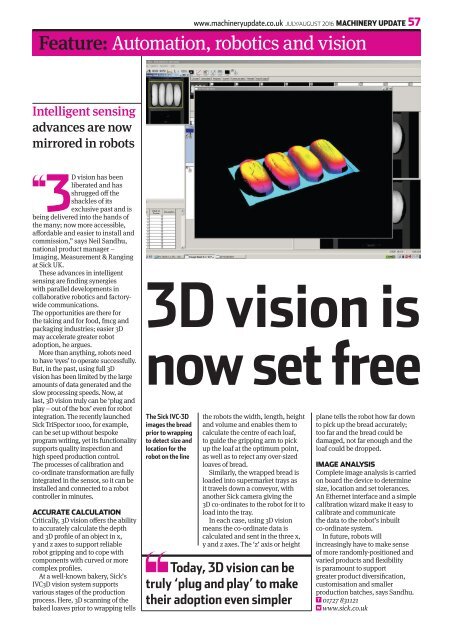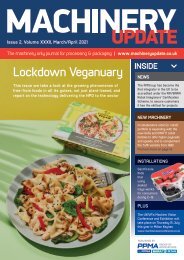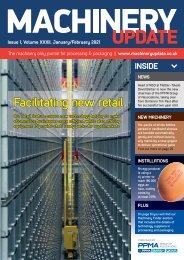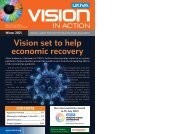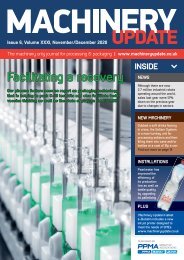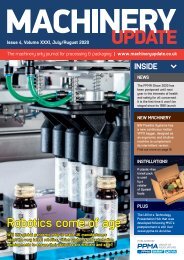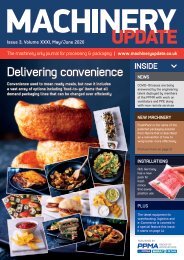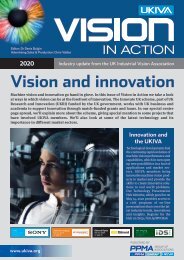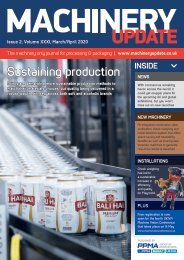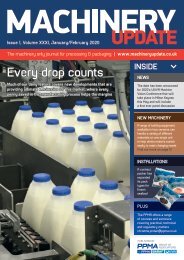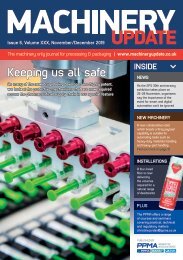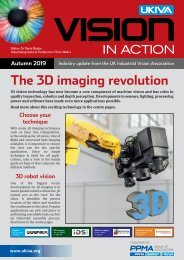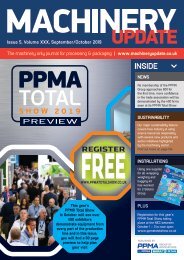MU July / August 2016
Machinery Update Issue 4, Volume XXVII, July / August 2016
Machinery Update Issue 4, Volume XXVII, July / August 2016
Create successful ePaper yourself
Turn your PDF publications into a flip-book with our unique Google optimized e-Paper software.
www.machineryupdate.co.uk JULY/AUGUST <strong>2016</strong> MACHINERY UPDATE 57<br />
Feature: Automation, robotics and vision<br />
Intelligent sensing<br />
advances are now<br />
mirrored in robots<br />
3D vision has been<br />
liberated and has<br />
shrugged off the<br />
shackles of its<br />
exclusive past and is<br />
being delivered into the hands of<br />
the many; now more accessible,<br />
affordable and easier to install and<br />
commission,” says Neil Sandhu,<br />
national product manager –<br />
Imaging, Measurement & Ranging<br />
at Sick UK.<br />
These advances in intelligent<br />
sensing are finding synergies<br />
with parallel developments in<br />
collaborative robotics and factorywide<br />
communications.<br />
The opportunities are there for<br />
the taking and for food, fmcg and<br />
packaging industries; easier 3D<br />
may accelerate greater robot<br />
adoption, he argues.<br />
More than anything, robots need<br />
to have ‘eyes’ to operate successfully.<br />
But, in the past, using full 3D<br />
vision has been limited by the large<br />
amounts of data generated and the<br />
slow processing speeds. Now, at<br />
last, 3D vision truly can be ‘plug and<br />
play – out of the box’ even for robot<br />
integration. The recently launched<br />
Sick TriSpector 1000, for example,<br />
can be set up without bespoke<br />
program writing, yet its functionality<br />
supports quality inspection and<br />
high speed production control.<br />
The processes of calibration and<br />
co-ordinate transformation are fully<br />
integrated in the sensor, so it can be<br />
installed and connected to a robot<br />
controller in minutes.<br />
ACCURATE CALCULATION<br />
Critically, 3D vision offers the ability<br />
to accurately calculate the depth<br />
and 3D profile of an object in x,<br />
y and z axes to support reliable<br />
robot gripping and to cope with<br />
components with curved or more<br />
complex profiles.<br />
At a well-known bakery, Sick’s<br />
IVC3D vision system supports<br />
various stages of the production<br />
process. Here, 3D scanning of the<br />
baked loaves prior to wrapping tells<br />
3D vision is<br />
now set free<br />
The Sick IVC-3D<br />
images the bread<br />
prior to wrapping<br />
to detect size and<br />
location for the<br />
robot on the line<br />
the robots the width, length, height<br />
and volume and enables them to<br />
calculate the centre of each loaf,<br />
to guide the gripping arm to pick<br />
up the loaf at the optimum point,<br />
as well as to reject any over-sized<br />
loaves of bread.<br />
Similarly, the wrapped bread is<br />
loaded into supermarket trays as<br />
it travels down a conveyor, with<br />
another Sick camera giving the<br />
3D co-ordinates to the robot for it to<br />
load into the tray.<br />
In each case, using 3D vision<br />
means the co-ordinate data is<br />
calculated and sent in the three x,<br />
y and z axes. The ‘z’ axis or height<br />
Today, 3D vision can be<br />
truly ‘plug and play’ to make<br />
their adoption even simpler<br />
plane tells the robot how far down<br />
to pick up the bread accurately;<br />
too far and the bread could be<br />
damaged, not far enough and the<br />
loaf could be dropped.<br />
IMAGE ANALYSIS<br />
Complete image analysis is carried<br />
on board the device to determine<br />
size, location and set tolerances.<br />
An Ethernet interface and a simple<br />
calibration wizard make it easy to<br />
calibrate and communicate<br />
the data to the robot’s inbuilt<br />
co-ordinate system.<br />
In future, robots will<br />
increasingly have to make sense<br />
of more randomly-positioned and<br />
varied products and flexibility<br />
is paramount to support<br />
greater product diversification,<br />
customisation and smaller<br />
production batches, says Sandhu.<br />
T 01727 831121<br />
W www.sick.co.uk


